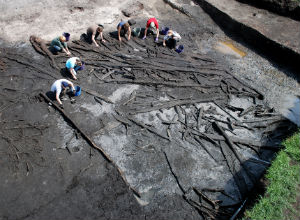Prehistoric people resilient in the face of extreme climate events
26 March 2018

Pioneering early people who lived at the end of the last ice age were far more affected by relatively local changes to their environment than they were by the plummeting temperatures, a study at a world-famous archaeological site in North Yorkshire suggests.
A research team including the University of Reading found that the severe average temperature drop, enough to halt the development of woodland, had no substantial impact on human activity at Star Carr – a middle Stone Age archaeological site dating to around 9,000 BC.
The study, published today in Nature Ecology and Evolution, found that these communities left evidence that they were able to cope with extreme and persistent temperature change, and were in fact only forced to abandon the area when a large lake that they relied on for resources began to dry up and turn into fenland.
"It was actually localised changes that had the biggest impact on their lives" - Dr Alison MacLeod, University of Reading
Dr Alison MacLeod, a co-author in the Department of Geography & Environmental Science at the University of Reading, said: “This evidence sheds new light on the debate about how sensitive early hunter-gatherer societies were to environmental change.
“Our work shows those living at the end of the ice age were remarkably resilient to the large-scale climate event going on around them, and it was actually localised changes that had the biggest impact on their lives.”
Ice extent began to reduce 11,500 years ago in response to climate warming following the last glacial episode. This transitional phase was characterised by significant climatic instability and extreme weather events. The rich archaeological record at Star Carr gave the researchers the rare opportunity to directly compare the palaeoclimate record with evidence of human activity through time in the same location.
Endurance
The prehistoric community, who persevered through the cold snap that would last more than 100 years, left a plethora of worked wood, animal bones, antler headdresses and flint blades at Star Carr as evidence of their continued productivity and endurance. The researchers examined remains recovered from layers of mud at the edge of the former lake basin in the Vale of Pickering.
They found evidence of houses on the lake edge and large quantities of artefacts and bones, which were radiocarbon dated. Pollen, macrofossils and isotopes taken from lake sediment cores allowed the researchers to build a high-resolution picture of the climate of the area over thousands of years.
The team identified two episodes of extreme cooling which saw average temperatures drop by more than 3°C in the space of a decade. The first of these events occurred very early after humans began to return to the area after the last ice age.
The evidence indicates that these conditions may have slowed down the progress and activity of a community in the nascent stages. However, the second of these events, which occurred later when the community was more established, appeared to have very little impact.
The study was conducted by Royal Holloway, University of York, University of Southampton, University of Chester, University of Manchester, Historic England, University of Stirling, University of Reading, Lancaster University, University of Oxford, , Keneperu Science Center( New Zealand) and University of Glasgow.
The work was funded by the European Research Council, Historic England, the Natural Environment Research Council, The British Academy, The Vale of Pickering Research Trust, and the Universities of Chester, Manchester and York.
Full reference:
S. Blockley, I. Candy, I. Matthews, P. Langdon, C. Langdon, A. Palmer, P. Lincoln, A. Abrook, B. Taylor, C. Conneller, A. Bayliss, A. MacLeod, L. Deeprose, C. Darvill, R. Kearney, N. Beavan, R. Staff, M. Bamforth, M. Taylor, N. Milner (2017). 'The resilience of postglacial hunter-gatherers to abrupt climate change'. Nature Ecology & Evolution. doi:10.1038/s41559-018-0508-4
